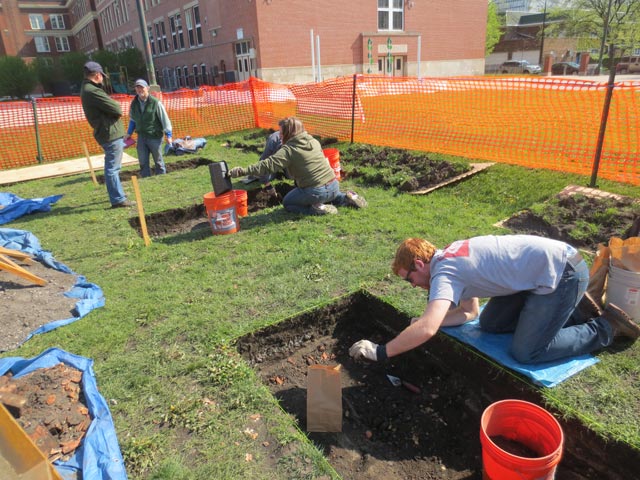Archaeologists Dig Into Chicago’s Grisliest History In Douglas Neighborhood

Archaeologists looking for Camp Douglas relics in the Pershing Magnet School yard near 33rd and Calumet. (jmogs)







In September 1861, the Army built a training facility on land largely owned by Senator Stephen A. Douglas, the “Little Giant” of Lincoln-debating fame. But from 1862 through the end of the Civil War, it operated as an prisoner of war camp in the prairie just outside Chicago’s city limits.
It was a frightful place.
Sitting roughly between 31st to 33rd Place and Cottage Grove to Giles Avenue, Camp Douglas at one point squeezed 12,000 men into its infrastructure-limited 80 acres. Disease and exposure to the elements took its toll.
In February 1863, 10 percent of the Camp’s inhabitants were lost, marking the deadliest month in any Civil War prison camp. More than 4,000 prisoners were known to have died on the site and the mortality rate for those passing through the camp may have been as high as 23 percent over the course of the war. Conditions were so horrid that the place seems to have given birth to the phrase “hell in a hand basket.”
And within six months of the end of the Civil War, it had been wiped away. A couple decades later it was hardly even a memory, replaced by a neighborhood that bore the same name, but looked far different, serving as a proving ground for some of Chicago’s greatest architects.
Today, an effort is afoot to revive and mark the memory of this unfortunate chapter in Chicago history. The Camp Douglas Restoration Fund has organized a series of archeological digs in search of remnants of the prison camp.
This weekend, orange fencing surrounded volunteers as they slowly dug into the grounds of the Pershing Magnet School in the 3200 block of South Calumet. With the help of archeologists from the Field Museum, as well as Loyola and DePaul Universities, the dig has unearthed bottles, buttons, glass shards, and perhaps footers to buildings in the midst of what would have been the prison barracks, though it remains to be seen if any of it is contemporaneous to the camp.
Eventually, the Camp Douglas Restoration Fund intends to reconstruct one of those forsaken buildings which would serve as a museum to tell the prison camp story, as well as highlight the African American Civil War experience. The project would serve as interesting connective tissue to an Obama Presidential Library if it was located on the former Michael Reese Hospital site just a few blocks away on 31st—connecting the Obama story with nearby Civil War and jazz era sites like the Stephen A, Douglas tomb and former Sunset Cafe, as well as the more distant Lincoln Presidential Library in Springfield.
A cable documentary entitled “80 Acres of Hell” dramatized the grisly camp:
http://chicagoist.com/2014/05/19/archaeologists_dig_into_chicagos_gr.php#photo-1
